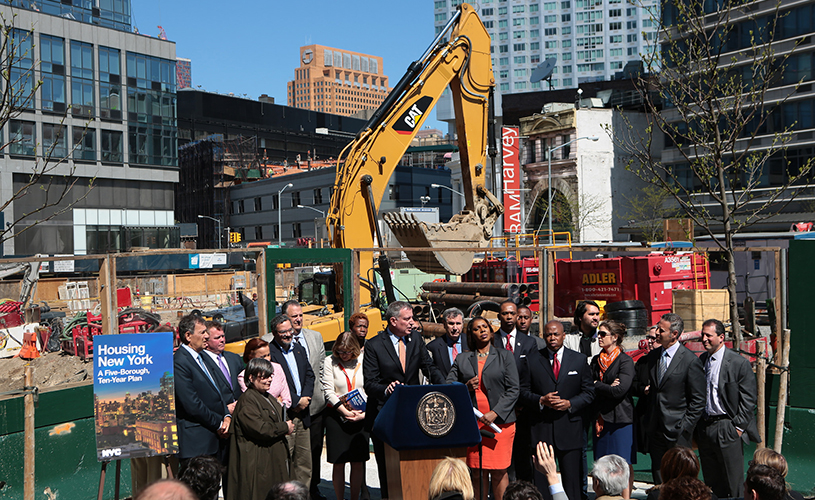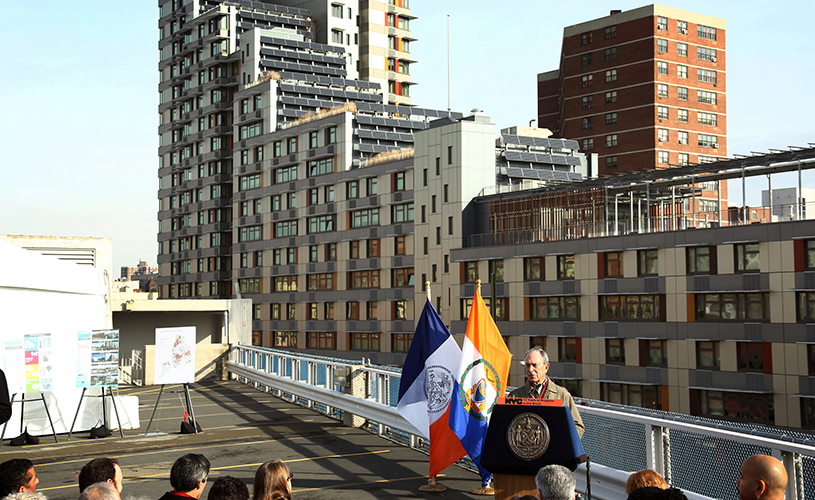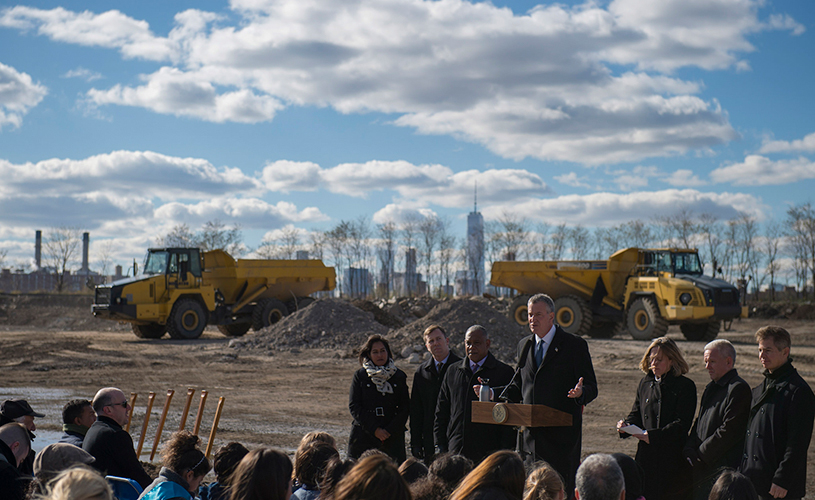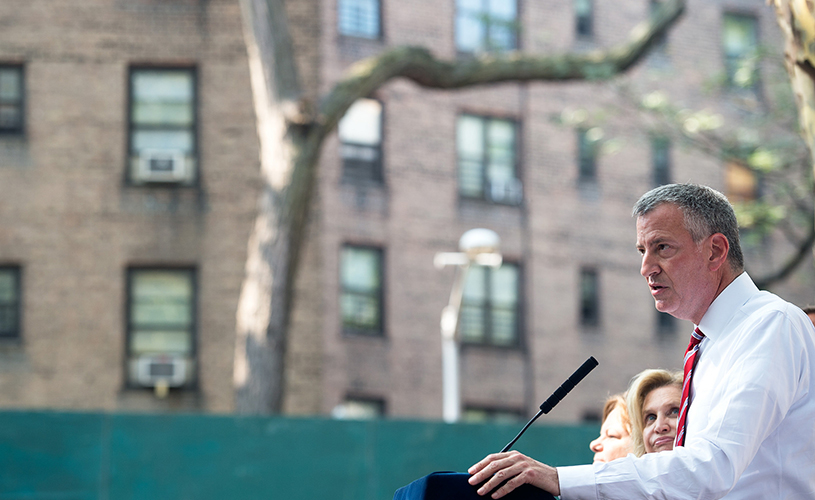
New York City Mayor Bill de Blasio and First Lady Chirlane McCray introduce then-United States Secretary of Housing and Urban Development Julián Castro to celebrate housing legislation passed by the City Council in 2016. (Michael Appleton / Mayoral Photography Office)
With its sky-high rents and soaring property values, it’s no secret New York City struggles with affordable housing. As the city grapples with potential solutions, such as whether to rezone neighborhoods to create a mix of market-rate and “affordable” housing, or to build a partly affordable housing complex in Brooklyn Bridge Park, or to lease New York City Housing Authority land to developers who will create a mix of affordable and market-rate housing, it is important to remember this fact: Most of the housing in New York City Mayor Bill de Blasio's 200,000-unit affordable housing plan already exists.
The plan includes a four-unit brownstone on West 131st Street in Manhattan and 510 Atlantic Ave., a Brooklyn high-rise with 202 apartments. It encompasses a single-family home not far from John F. Kennedy Airport in Queens, 454 units in a Staten Island building called Castleton Park Apartments, or a five-story Bronx walk-up a few steps from the cottage where Edgar Allen Poe wrote “The Bells.”
When the mayor talks about his plan “to create or preserve 200,000 units of affordable housing,” those properties are in the “preserve” part. They may have been built decades ago (the Bronx walk-up is 106 years old) and may even have been part of an earlier city housing program – as was the case for the building on West 131st Street, which was included in former Mayor Ed Koch's 10-year plan for affordable housing. But now those units will continue to provide affordable housing thanks to funding the de Blasio administration has provided to address repair issues, provide new financing to landlords who agree to keep renting apartments to people in specified income bands or to homeowners who themselves are in one of those income groups.
RELATED: Is affordable housing New York's white whale?
Those preservation deals are the bulk of what de Blasio promised on that sunny day in May 2014 when he unveiled his Housing New York plan. The backdrop to that announcement was the rebar and heavy machinery of a construction site, but it more accurately would have been a tub of joint compound or a loan agreement. While the mayor's plan pledged to create 80,000 units of new affordable housing over the next decade, he promised to preserve 120,000 units.
“You’re going to see an intensive effort over the course of these coming years, driving every day to create one more unit, to preserve one more unit,” de Blasio said that day. “Every additional unit that we make affordable, every additional unit that we build, means one more family that finally has economic stability, that finally has a brighter future. That’s how we look at it. There’s going to be an urgency about adding one more and one more and one more again on the way to our goal.”
According to the latest count released by the city Department of Housing Preservation and Development in July, the administration is ahead of its scheduled housing targets. That's especially true on the preservation side: With 52,309 units started, the preservation promise is 44 percent fulfilled.
The 25,342 units of new construction started so far represent 32 percent of the Housing New York goal. But that work tends to get all the glory, and the gripes, in the media and during political conversations about housing policy. Mandatory Inclusionary Housing, Zoning for Quality and Affordability, the neighborhood rezonings from East New York to Jerome Avenue, the NextGen NYCHA plan – these all primarily concern the creation of new housing.
Meanwhile, the preservation side of the affordable housing equation gets little attention and, according to some sources, is poorly understood. The concept of preservation is more complex than it sounds and the nature of housing preservation has changed dramatically over the four decades New York City administrations have implemented affordable housing plans. While housing advocates and experts overwhelmingly agree that the de Blasio administration's preservation numbers are “legit,” many also believe those changes – and some of the challenges inherent in preservation work – deserve more public discussion. After all, the recent $1.9 billion increase in the city's 10-year capital plan for housing more than doubles funding for preservation.

New York City Mayor Bill de Blasio unveils "Housing New York" in May 2014. (Ed Reed / Mayoral Photography Office)
Affordable housing has been a goal of municipal government at least since the New Deal, when former Mayor Fiorello La Guardia pioneered public housing. Modern city housing policy dates to Koch's 10-year plan, which aimed for 252,000 units of housing. A New York Times analysis published in 1986, just after Koch outlined his expanded initiative, mentioned that one of the goals was “to rehabilitate rotting tenements.” In fact, preservation dominated the Koch plan. Of the 141,000 housing units attributed to the 10-year plan, just 15 percent were new construction. The rest were 43,000 units of “gut rehabilitation” and 76,000 units of “preservation/moderate rehabilitation,” according to an authoritative count published in 1999.
The backdrop to de Blasio’s Housing New York announcement was the rebar and heavy machinery of a construction site, but it more accurately would have been a tub of joint compound or a loan agreement.
Former Mayor Michael Bloomberg's 2006 housing plan, called The New Housing Marketplace Plan, took a different tack. It emphasized new construction over preservation, calling for a 56/44 percent split. This orientation reflected the moment: The city's development boom hadn't really taken hold, so the driving desire was for more units. The financial crisis of 2007-2008 changed that thinking. “The financial markets had essentially collapsed. The Low-Income Housing Tax Credit market was frozen and it was unclear where that was going and you were seeing significant amounts of foreclosure in the single-family market, and there was a real fear that the crisis would spread to the multifamily housing market,” recalled Rafael Cestero, who served as New York City Department of Housing Preservation and Development commissioner from 2009-2011. The worry was the recession could create a situation similar to the 1970s and 1980s when apartment building owners were unable to get financing and simply walked away from their properties. “So we said, ‘Alright, how do we respond to this?’ The combination of this fear about what was going to happen in neighborhoods and the contraction in funding for multifamily housing led us to shift our finances,” Cestero said. He now leads the Community Preservation Corp., which finances affordable housing construction and preservation.
The New Housing Marketplace strategy shifted in light of market conditions to a mix of 68 percent preservation and 32 percent new construction. De Blasio’s Housing New York initiative targeted a 60/40 split from the start.
It’s been more than the just the numerical targets that have changed from one mayor to the next. The nature of preservation work also shifted during the two decades between the Koch and Bloomberg plans.
“Preservation has a very different meaning than what it meant under the Koch plans,” said John Reilly, a veteran manager of affordable housing who leads the Fordham Bedford Housing Corp. in the Bronx. In the Koch days, Reilly said, “Preservation very much meant saving a building from further deterioration or abandonment. Affordability was an issue, but not the primary one, as rents hadn’t taken off like they have today, and the existing rent protections were stronger and better monitored and enforced.” Or as one former city housing official put it: “Preservation used to be as a word synonymous with rehab.” The targeted housing, the official said, “was physically unusable, was going to die without (the city’s intervention).”
And in many cases, the city owned the housing that needed to be rehabbed. “One of the biggest differences during the Koch era, we were taking a lot of property into city ownership each year,” said Kim Darga, HPD’s associate commissioner of preservation. “A lot of the Koch plan focused on strategies to convey that property back into private ownership, and where there were renovation needs, to renovate the properties.”
RELATED: Housing New York is making slow, but steady progress
Under Bloomberg, the approach began to change. The physical preservation of properties – replacing wallboard, redoing plumbing, fixing roofs – began to be supplanted by financial operations aimed at permitting or enticing landlords to keep rents affordable to low-, moderate- or middle-income people. Nowadays, a preservation deal could involve no physical work at all, and consist instead of the city offering cheap financing or tax breaks in exchange for the owner signing or renewing a regulatory agreement to keep the apartments affordable.
“We used to preserve housing,” is how one affordable housing provider describes it. “Now we preserve affordability.”
“And that's not a bad thing,” the former HPD official notes – because, after all, “It's a different city.”
In part because of the success of the Koch plan, housing quality in New York is better than it was in the 1970s or 1980s. Some of the neighborhoods plagued by decrepit apartments, abandoned buildings and vacant lots in the days of urban crisis are now hotspots for market-rate development. So the main threat isn't unlivable apartments, but the incentive for owners to hike rents and displace low-income people.
“We used to preserve housing. Now we preserve affordability.” – unnamed affordable housing provider
HPD and the de Blasio plan have adapted to the new landscape. “Owners – many of them – can potentially refinance, especially given the value of property in New York City, and take money out in order to do renovations on their own,” Darga said. “So, while we still have robust programs that focus on renovating property, that’s not the only need that we’re trying to address today because we’re also trying to complement or build out the tools that people have access to on their own.
“Sometimes it’s physical, sometimes it’s financial and sometimes it's both,” she said. “The affordability outcome is still what we’re solving for there.”
According to the latest detailed numbers from HPD, which covers projects started between de Blasio’s inauguration and this March, the agency has funded 1,126 buildings to do at least some physical rehab and 268 buildings for purely financial preservation. In other words, about one-fifth of the preservation units recorded so far have been in buildings in which physical work was not funded.

Then-New York City Mayor Michael Bloomberg announces the city will reach 160,000 units of affordable housing by the end of 2013. Bloomberg’s plan emphasized new construction over preservation, calling for a 56/44 percent split. (Ed Reed / Mayoral Photography Office)
While both forms of housing intervention – the physical and the financial – are considered “preservation,” some wonder if they are truly equivalent. There is certainly a difference in method between making a home physically viable again versus paying a landlord to keep rents below a certain threshold. From the perspective of trying to increase the number of housing units that are affordable in the city, however, preventing subtraction is the same as facilitating addition. “From a tenant’s perspective, if they're living in a high-quality affordable unit do they care if we’re just providing a financial beneficial or if we’re providing subsidy for renovations and the benefit?” Darga asked.
The change in the nature of housing preservation does make historical comparisons a little difficult. “Everybody has defined it differently, so it's ‘squishy’ in that sense,” a housing policy expert said. “But it's not deceptive.”
Benjamin Dulchin, executive director of the Association for Neighborhood and Housing Development – an organization that represents nonprofits that build affordable housing – concurred: “Preservation is a very legitimate category. It correctly should be the bulk of their plan. It is the most cost-effective way to maintain affordability and so we don't think of the category of preservation as being inherently weaker than the category of new construction.”
HPD has rules governing what it can count as part of the Housing New York plan, and not every apartment that receives some assistance gets counted: At least 7,000 units have been “assisted” since the start of the administration, meaning they took some help from the city but weren't in a situation where it made sense to lock in a new regulatory agreement. So they will not be counted as part of the preserved units on the way to de Blasio’s 200,000-unit promise.
“Preservation correctly should be the bulk of their plan. It is the most cost-effective way to maintain affordability.” – Benjamin Dulchin, executive director of Association for Housing and Neighborhood Development
The agency's statistics indicate that preservation has been disproportionately located in Manhattan to date. The borough has 36 percent of the preservation units financed so far compared with only 19 percent of the new construction units. The opposite is happening in the Bronx. The city has constructed 38 percent of its new units there, but a smaller 27 percent of the preservation portfolio is located in the borough.
Those numbers, however, don't capture the full scope of the administration's preservation efforts, which include long-standing initiatives like the Emergency Repair Program where HPD steps in to correct serious repair issues and sends landlords the bill, or the city's policy of paying for lawyers to represent low-income people facing eviction in Housing Court – both of which involve affordable housing. The administration’s attempts to deal with the backlog of capital work on NYCHA buildings will help preserve the city’s most valuable affordable housing resource, but they will largely not be part of what’s counted toward the Housing New York goal. And the two-year rent freeze for regulated apartments had the effect of delaying some number of affordable units from leaving the rent-regulation system through high-rent vacancy decontrol, which deregulates a unit once it is vacated and its rent surpasses $2,700.
On the other hand, the Housing New York numbers also fail to capture what’s going on in the broader housing market, where thousands of units have become priced out of affordability even as the mayor tries to bolster the affordable stock. According to a tally by the New York City Rent Guidelines Board, some 27,000 units have left rent stabilization during the first three years of de Blasio’s term.
That’s why many housing advocates wish there was less focus on the headline goal of 200,000 units. It might be a useful policy ceiling, but won’t serve as accurate indicator of whether the mayor’s policy has succeeded or failed at making the city more affordable.

New York City Mayor Bill de Blasio breaks ground on Phase II of Hunter’s Point South. (Ed Reed / Mayoral Photography Office)
One danger in broadcasting a large numerical target is that it could create an incentive for housing officials to aim for deals that produce higher unit counts, but might be less valuable in other ways to a neighborhood. The same kind of tension could affect the preservation program if the agency had to choose between physical rehab deals and projects that exist only on paper and might be easier to complete.
Darga dismissed that concern. “Right now, it's not a zero-sum game,” she said. Since deBlasio has committed a lot of money to the housing initiative, HPD deals with what comes through the door, she said. “We largely base our capital budget for preservation ... on pipeline and demand.”
There will always be questions, of course, about whether the city is getting enough bang for its buck. Any doubts that have emerged about the de Blasio administration’s preservation strategy arose because of the highest profile project in its portfolio so far: the Stuyvesant Town deal cut in 2015. The new owners of the sprawling complex, where apartments had quickly been slipping out of rent stabilization, agreed to keep 5,000 units in the rent regulation system in exchange for financial help from the city. The mayor hailed it as “an achievement that helps us ensure we can keep this a city for everyone.”
But the city initially disclosed only the $144 million in cheap financing the owners would get; reporters’ questions shook loose the news that $77 million in waived mortgage recording taxes were also part of the deal. Still later came word that the city had also agreed to help the new owners monetize the complex’s air rights, a potential windfall for the landlords. And all that for units that were overwhelmingly targeted toward households making $128,000 a year for a family of three and able to afford $3,000 monthly rents.
“There are a surprising number of owners out there who say, ‘I've owned this property a long time. I know these residents and I don't necessarily want to kick all these people out and I don't necessarily want to sell.’” – Kim Darga, associate commissioner of preservation at HPD
The Citizens Budget Commission recently raised broader concerns about the financial transparency of the city’s affordable housing plan. It faulted the city for failing to specify how much it has spent per unit under the different facets of the plan, and for refusing to disclose how much money has been used under each of its many different construction and preservation programs. “Without this basic data,” the CBC wrote, “whether the mayor’s Housing New York plan is deploying its capital in the most cost-effective way cannot be evaluated.”
A spokeswoman for HPD said the city approves a maximum subsidy of $35,000 per unit under the Multifamily Housing Rehabilitation Loan Program and from $40,000 to $90,000 per unit in the Participation Loan Program, to give two examples of preservation funding. There are 30 preservation programs and HPD does not divulge how many units have been preserved under each one, she told City & State.
Darga insisted HPD analyzes each deal to make sure the city is getting something worth what it’s giving. “It’s a basic cost-benefit analysis: What is the cost to the city of providing that tax exemption or the financing to the owner and what is the city getting in exchange for providing that tax exemption?” She said the agency does say no, sometimes, typically to owners who want to target income groups that HPD believes are poorly aligned to the needs of a neighborhood. There’s often a back-and-forth. To some degree, the outcome depends on the owner’s mindset more than the math.
“There are some owners that are going to look at what they could get in selling to the purchaser who is going to pay the most and when given a choice between preserving the affordability – and us providing financial benefits so that they have a viable, affordable property long term – and that choice of selling, they’re going to sell. They just don’t want to deal with the regulation and they’d rather have the quick infusion of cash. That is their business model,” Darga explained. “But there are a surprising number of owners out there who say, ‘You know what? My business model is I'm going to hold this longer term. I'm going to hold this for the long run,’ or ‘I’ve owned this property a long time. I know these residents and I don't necessarily want to kick all these people out and I don’t necessarily want to sell.’”
Nonprofit owners are typically driven by such considerations because of their mission, but she said for-profit landlords sometimes make the same choice.

Since the preservation pipeline is driven by the buildings and ownersthat come through the door, the city can’t be certain which income groups will be served by preserved units. (Demetrius Freeman / Mayoral Photography Office)
To some extent, the biggest challenge for HPD isn’t making a deal but getting landlords to the table in the first place. For a host of reasons – one being that HPD is seen by many property owners as an enforcement agency rather than a resource – this has always been a struggle. But these days, Elizabeth Zeldin, Senior Program Director of Enterprise Policy:Community Partners said, “The market is so strong that the value of a government subsidy is pretty low relative to the value of keeping a project unsubsidized. And private financing is not super expensive.”
Cestero concurred that the preservation pitch to landlords is tougher these days. “I think that it is harder because the market is different,” he said. “Ithink it is harder because the politics are different. I think it is harder because the quality of a building has become synonymous with the quality of a landlord.” That can make it hard for the city to work with controversial property owners.
All told, the challenges have forced the city to be creative. HPD tweaked most of its preservation programs in 2013, and two years later introduced a Green Housing Preservation Program to attract owners who were willing to accept regulation in exchange for financing to achieve efficiencies on energy use or water consumption. And HPD has focused a lot, Darga said, on improving awareness and access to its various programs.
According to Ginsburg, making the math work for preservation is more difficult than for new construction, where there are more opportunities to cross-subsidize high rents from market-rate units to help pay for the rent-restricted ones or use supportive housing funding.
RELATED: De Blasio the developer
De Blasio’s original Housing New York plan called for work with the state to create new tax incentives for preservation, but that hasn't happened. HPD has said it finds the existing tax abatements – J-51, 420-c and Article XI – flexible enough. Cestero, for one, thinks new tools are needed. He has proposed an as-of-right preservation tax abatement “that is less complicated and cumbersome to administer than the J-51 program.” But that's a controversial idea because it might grant high-profile “worst landlords” a tax break to get their buildings into basic compliance with the law. Others have said programs – like the Third Party Transfer Program – that are designed to get tax-foreclosed properties renovated and back into private hands could be updated to better meet today’s property needs.
HPD is well on pace to meet the broad numerical targets for preservation by the time the de Blasio plan is complete. Less certain is the affordability mix in those units. About half the preservation money in the updated capital plan is earmarked for “extremely low-income” or “very low-income” households, compared with about a quarter of the new housing construction money. So far, the preservation units in the de Blasio plan are exceeding goals at the extremes. There is a higher share of extremely low- and very low-income units on the bottom end and more middle-income units on the high end than what was initially targeted by de Blasio in 2015. There is a lower share of low-income and moderate-income units preserved than what was targeted. But that could easily change as the plan matures.
Since the preservation pipeline is driven by the buildings and owners that come through the door, the city can't be certain which income groups will be served by the units preserved in any particular year. Darga said HPD used to dictate that preservation buildings continue to serve the same income groups that currently live there, but that approach wasn’t flexible enough. Now, she said, HPD might cut a deal that involves both higher-income units and apartments for the homeless – a high-low approach that can generate the kind of rent revenue an owner needs to sign on.
Not that the city is sitting back and waiting for deals. It’s looking, even at buildings where there’s no existing regulatory agreement, like the Stuy Town deal and a similar one at the Riverton complex in Harlem. And that’s an area where new policy mechanisms might come in handy.
“The city has sort of cast their eye about on relatively affordable, private rent-stabilized properties and seeing where they have leverage – where they can provide some level of financing or tax abatement in order to get the landlord to agree to a reg agreement that somehow restricts the rent,” Dulchin said. “There is no cookie-cutter model for that. We’d need to go into the details to know if we think they’re getting the right bang for their buck and whether every deal is worth it but, honestly, the intent is a good one.”
Dulchin added, “Did they overpay for the affordability they preserved at the Riverton or at Stuy Town? Yeah, they probably did, but they also didn’t have better tools to use, and it's good that they’re trying.”

This story was produced by City Limits in partnership with City & State. Jarrett Murphy is the executive editor of City Limits.


